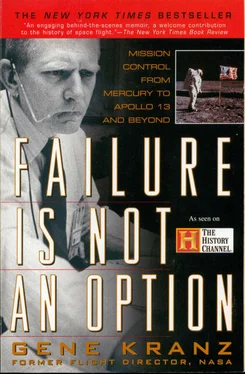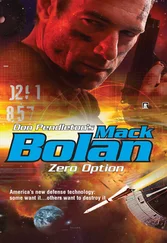I looked around the room and saw faces drained of blood. John Glenn’s life was in peril. We were desperate to find a solution, without being sure we knew the problem.
Kraft said, “This is the wrong way to go. It’s too damn risky for something that is probably an instrument error.” Fighting to avoid a premature decision, Kraft fired off a barrage of questions: “Does anyone know the aerodynamic effects of reentering with the retropackage attached? Do we have sufficient control with the attitude jets to keep us oriented in reentry attitude? Will we damage the heat shield to the point where it cannot protect the capsule as the retropack melts away during reentry?” Faget and Yardley scratched their heads. They were well beyond the bounds of their design knowledge.
Faget, quietly muttering in his Cajun accent, tried to reassure Kraft. “Chris, it should be okay. We designed the heat shield with plenty of margin.” His words did not sound convincing. Kraft’s gut feeling indicated just the opposite. He believed Segment 51 was a false telemetry indication and the risks of an unproven, untested entry technique with the retropack were too high. Kraft exclaimed, “Dammit, we’ve got to find other pieces of data to confirm this before we jump to the conclusion to enter with the retropack.”
Slayton and Shepard had plugged into Kraft’s console for the telephone conversation with the blockhouse. Returning to his console, Williams leaned over and asked, “What should we tell John?” Kraft ignored the question for the moment.
Faget, the consummate engineer, could not ignore the telemetry. Engineers like Max live by their data. Asking one of them to consider that the telemetry information may be wrong borders on the heretical. Kraft was at the opposite end of the spectrum. “Max, dammit,” he barked, “we only got one piece of instrumentation. My guys tell me it would take a dual electrical failure for the heat shield to come loose. The way it is stacked, a mechanical failure is out of the question.”
Yardley, who had been conferring with Williams, posed the fatal question: “Chris, what happens if it is valid?”
With only a single data point, the discussion was at an impasse.Williams joined in: “If we come in with the retropack attached, what is the worst thing that can happen to us?” (I could imagine Glenn’s reaction, if he only knew: “What’s this us crap?”) No new information was forthcoming, but at least there was now a grudging acceptance for Kraft’s position that the telemetry indicator could be wrong.
The debate at the console broke off again as Cooper came on the conference loop to offer his impression of the problems reported by Glenn over Australia. Kraft knew the discussions were bothering his controllers on the floor and motioned the entourage to return to their seats. I noted the clock. The mission was half over and the team needed to make a decision in less than two hours. I made one more trip to my McDonnell engineers, who had been on the phone back to the plant in St. Louis. I doubted they would have any answers prior to entry.
Kraft was again seated at his console when I returned. For a few moments, it seemed that everything had settled down. My console was flooded with Teletype messages and I scanned the most recent arrivals first. The message from the Canton site brought me to my feet and I handed it to Kraft. The message said:
ALL
DE CTN
FM CAPCOM
CTN ADVISED S/C NO INDICATIONS LDG BAG DEPLOY.
S/C RESP DID SOMEONE ASK IF THE LDG BAG WAS DOWN?
CTN RESP WE HAVE BEEN ASKED TO MONITOR LDG BAG AND ASK
IF YOU HEARD NOISES WHEN MANEUVERING.
S/C RESPONSE NEG.
Teletype messages between the tracking stations and MCC are always abbreviated and terse to save transmission time. This message was painfully clear. The Canton Island CapCom (CTN) had inadvertently informed Glenn (S/C or spacecraft) of our concerns.
Kraft had staked out his position long ago: “I don’t worry about things I can’t do something about.” But in this case, he was worrying a great deal. The impasse on entry techniques bothered him. Left to his own he would press on with a normal entry, ignoring the alarm, but Yardley and Faget were two damned good engineers arrayed against him. Williams also had flight test savvy. They were all telling him he should take a different path.
Still, Kraft had picked up the scent. He believed he was on the right track and wanted to buy more time. “I want to give John a complete story,” he explained, “and I need more answers.”
Over Hawaii, Glenn was given the Go for the final orbit. After the discussion with Canton, I was surprised John did not mention his conversation with the CapCom. During his last stateside pass, he continued discussing his attitude control problems, and we provided him with a recommendation for backing up the automatic attitude control.
My roommate, Carl Huss, updated the capsule retrosequence clock to the correct retrofire time for the planned end of the mission landing area. The clocks would automatically initiate the retrofire sequence if the spacecraft attitude was correct when the clock timed out. The mission now coasted into the third and final orbit. Under other circumstances, Huss and Tec Roberts would have been delighted. Their tracking data was solid and the planned retrofire times had not changed by even a second during the last orbit. With the decision time now down to less than an hour, I believed we had all the data we were going to get. Kraft and Williams were facing the lonesome task of deciding what to do. John Glenn’s life, the Mercury program, and America’s future in space were in the balance.
Looking back on this episode, and the other Mercury missions, I find it hard to believe that we did so well. The systems operators did not have the benefit of the massive analytical tools available today. The only computing resources available during the mission were used to process radar tracking data. Compared to the present technology, our computers were the equivalent of a rusty adding machine.
A controller lives or dies based on the information he has at his console. If you lack what you need at liftoff, there is little hope that you will get new information that you would trust during a mission. This realization was the most profound impression branded on me from the Glenn mission. During the final orbit I witnessed the agony and the frustration faced by the controllers and engineers wrestling to help Kraft make the best decision.
There was no right decision that day, nothing in black and white. We could only try to obtain the best answer. At that moment, I also realized that learning by doing was the only way a controller could ever become smart enough to succeed in the tough and unforgiving environment of spaceflight operations.
The last orbit was a stalemate. No more data was coming. The best judgment of the engineers was that there was sufficient attitude control for reentry with the retropack attached. The straps would burn off during entry and should not induce any landing position errors. Kraft restated his position: “It is an instrumentation problem. The heat shield is still attached. If we burn a hole in the damned heat shield we are going to kill Glenn!” Williams, rising to the emotion of the decision, chimed in: “Chris, if you’re wrong we are going to kill him, too.”
The engineers cautioned that if we kept the retropack attached, we needed to confirm that all three retros had fired. If one did not, there was a good chance it would detonate during reentry. Kraft did not comment on this last prediction.
Kraft was still holding out until the last moment, so that he had a complete understanding of the final instructions before he radioed up to John Glenn. The mission was turning into a horse race. Kraft wanted answers from one final test to be performed over Hawaii before he turned the discussion to the entry procedures modifications.
Читать дальше












